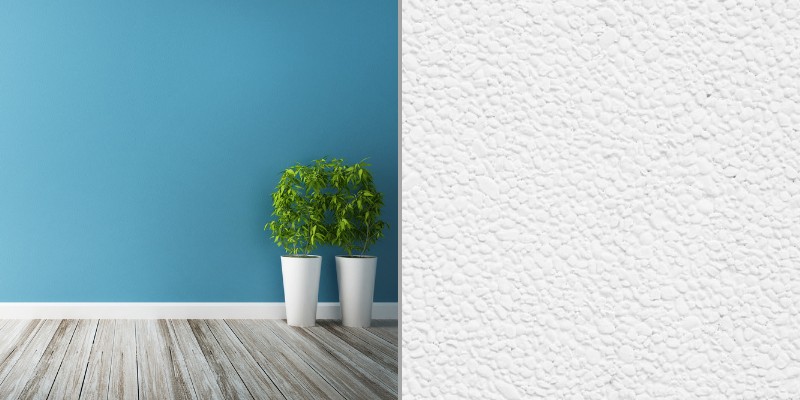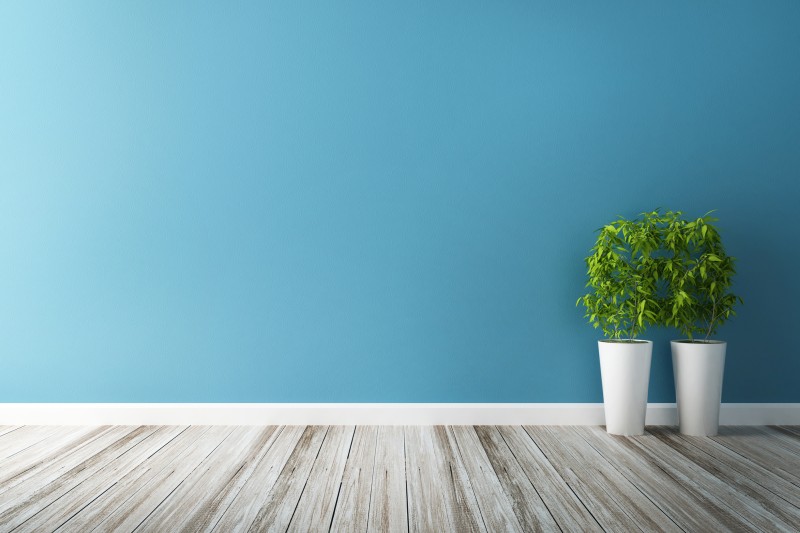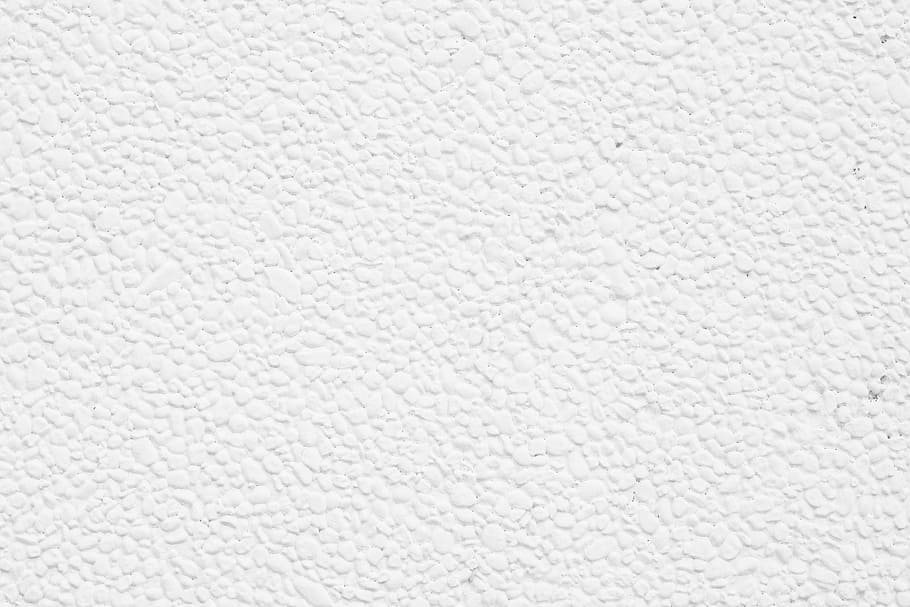Some Interior designers keeping track of the latest wall trends are telling their clients that “textured walls are in” currently. But is this really true? Let’s find out.

It seems folks sequestered during the pandemic began to notice all aspects of their environs and many realized that smooth walls were too stark for their sensibilities, yet they had no desire to return to the sponge painting phenomena that sprung up during the 1990s.
Fortunately, new techniques, methods and materials emerged, appealing to homeowners who love the idea of textured effects, thus the number of style options you can take advantage of if you decide to texture are huge.
Whether you stick with a fresh coat of paint or choose a texturized finish, learn more about the pros and cons of both interior wall finishes so you’re in a good place to make an informed decision.
In this article we’ll discuss and compare smooth vs textured interior walls in homes, so let’s get started.
What are Smooth Walls?
“Smooth” covers a myriad of descriptors, from coatings of wall paint that refresh existing surfaces to the use of “skim coat” products that help homeowners get rid of the textured patterns that are currently in place by smoothing out wall surface.
Smoothing textured walls is relatively common and involves using joint compound that has the proper consistency needed to fill in the recesses texturized wall surfaces have in common.

When the Los Angeles Times décor section surveyed homeowners back in 1988, 70-percent of homeowners wanted smooth interior walls so much, they were willing to pay more for them, but like other trends, the pendulum has again swung to textured walls.
Nevertheless, smooth walls remain the standard for commercial home builders, but you don’t have to stick to paint products to if you want smooth walls since the application of pressure-sensitive graphics can make a dramatic difference and no texturing is required that will have to be smoothed out down the road.
Interested in exploring pressure-sensitive graphics to get a “textured look” without the cost? Shop for products with peel-off backings like those featured in this New York magazine article and follow these instructions to do the job properly.
What are Textured Walls?
As we mentioned earlier, there has been such an explosion of textured wall products, methods and techniques, you are sure to find one that fits your needs, desires and skill level.

Choose from the following 3 easy methods recommended by Bob Vila whose “This Old House” brand remains a trusted resource.
- Comb. Use a drywall compound to “produce a repeated series of rainbow patterns on the drywall.” This method is easy, inexpensive and requires only a drywall trowel with evenly-spaced teeth to do the job.
- Popcorn. If retro walls are your objective, purchase a pre-mixed popcorn compound and rent an air compressor and hopper gun to handle the application. Prime walls first and follow instructions to achieve this 1970s look.
- Sand and Swirl effects requires a perlite primer application before creating swirling strokes using a 7-inch-wide paintbrush. Practice on a piece of drywall to get your rhythm down before you start at the ceiling and move down to the floor, tackling 5-foot sections at a time.
Smooth vs Textured Walls (Pros and Cons)
Smooth Walls
Pros
- -They deliver a timeless look
- -They are always in style
- -Easily and quickly repainted
- -The most affordable way to give a room a fresh look
- -Smooth walls match all furniture styles
- -They are cheapest way to revive walls
- -Allows you to showcase artwork and other interior elements
- -They’re the easiest to clean.
Cons
- -May not reflect your decorating aesthetic
- -There are 5 grades of smooth to consider (5 = smoothest)
- -Could make your walls look boring
- -Smooth walls may make you look unimaginative.
Textured Walls
Pros
- -Shows off your want to be different
- -Gives “ordinary” walls a unique vibe
- -Reflects your willingness to take decorating risks
- -Can pep up a drab room dramatically
- -Makes it easier to cover up a wall imperfection.
Cons
- -Could go out of style or look dated rather quickly
- -May make a small room look even smaller
- -Extremely expensive to install (DIY or contractor)
- -Even basic texturing techniques can fail in the wrong hands
- -Expensive to remove once installed
- -Grime collects faster on textured walls, making cleaning harder.
Current textured wall designs you won’t see coming and going
Are you aware of the fact that there are several ways to wind up with textured walls if you decide to go in this direction?
Some of the techniques you’ll read about here require artistry and time to create a unique finish that has dimension and flair, but you can also get what you seek without a lot of hard labor by investing in textured wall boards that only require the use of hardware to anchor them to drywall.
Décor authorities like Houzz recently showcased a variety of textured, pre-fabricated panels, one of which may be the style that can work magic on your walls if you like the look but prefer not to spend a fortune on a painter who has texturizing experience.
For those who want creative bragging rights, the first step on your journey is to gain inspiration from decorators who have successfully pulled off unique textured wall finishes, and there is no better resource for ideas and confidence-building than Pinterest where you’ll see imaginative textured finishes plus get tips on how to achieve them for yourself.
Are textured walls outdated?
Hardly, concludes decorator Lane Cooper posting on the Cooper Design Build website, but of course the application you pick can set a tone that differentiates current trendy textural styles from those that bring the 1970s to mind.
Differentiating between new trends and outdated ones is a personal call, but if you decide that you can’t live without textured walls, these are currently the most often-requested patterns by homeowners:
- -Install real wood paneling that doesn’t resemble 1970s faux wood.
- -Invest in a textured wallpaper. A current favorite among interior designers is grass cloth.
- -Avoid glossy, metallic papers if you don’t want your walls to be an homage to the 1960s.
- -Create an “excavated” look by using a crafting technique or go for peel-back bas relief murals.
- -Orange Peel uses drywall mud that’s sanded, dimpled, and applied by rolling, spraying or air compression.
- -Rosebud calls for pressing a circular brush into wet drywall to uniformly create bas relief “flowers”.
- -Craft a Crow’s Feet pattern by using a stiff brush pressed against wet drywall compound to achieve a familiar bird footprint pattern.
Smooth vs Textured Interior Walls Costs
Smooth Wall Paint Cost
There is perhaps no less expensive way to spruce up an interior smooth wall than by applying a new coat of interior paint.
For 2022, you can expect to spend anywhere between $15 and $40 per gallon for latex (water-based) paint.
Designer latex paint could run as much as $120 per gallon. Oil-based paint, a less popular option, runs around $40 per gallon.
Now, each gallon of paint can cover around 300-400 sq.ft of wall area. This is about the size of a small bathroom. With 2 gallons, you can paint an average size room (around 800 sq.ft).
This brings the cost of painting a smooth wall room of around $100 dollars in paint cost (excluding labor).
Textured Wall Cost
If you seek a ballpark estimate, a 500-square-foot texturized wall is likely to cost between $520 and $629 ($1.04 to $1.26 per square foot) if you hire a professional to do the job.
This range doesn’t consider the application of new and unusual patterns but does include labor, supplies and equipment rental.
It doesn’t include priming and/or patching damaged walls. This is not a project that should be handed to someone who has never texturized a wall before.
Various Texture Wall Styles
Perhaps it was being sequestered during the pandemic. Maybe it was simply the creative genius of designers who are receiving calls from clients for one-of-a-kind texturizing designs.
According to the DIG website, you could call upon a professional to produce any of these currently popular and unique texture wall finishes:
- Orange peel
- Knockdown
- Spray sand
- Sand swirl
- Skip trowel
- Slap brush
- Slap brush knockdown
- Spanish lace
- Venetian plaster finish
- Rosebud
- Hawk and trowel
Do Textured Walls Add Value?
The answer depends upon your long-term objective since both design preferences and taste are highly subjective.
The texturized finish you love may show off your creativity and style and reflect your willingness to take decorating risks, but texturizing happens to be a wildly fluctuating wall trend that can make rooms look smaller, outdated, and expensive to remove.
Further, textured walls are known to collect dust and grime, not a point you want your home to reflect if you put it on the market and seek to attract buyers who view extra cleaning tasks as burdens.
While consensus is that texturizing walls don’t add value, there is no shortage of experts willing to extol the virtues of this type of wall finish.
Some insist that texturizing is the single most effective way to hide holes, scratches and drywall damage that would require extensive repairs to rehabilitate the condition of a badly-damaged wall.
Further, texture can add character and depth to a wall. Surprisingly, textures offer a modicum of sound-dampening qualities that smooth walls cannot.
How much does it cost to smooth textured walls?
Some people that have textured walls in their home, down the road may decide to smooth out such walls.
The task of smoothing textured walls requires the use of a gel-type paint stripper to loosen the coating on the surface, at which point residue must be manually scraped off, a very labor-intensive task.
The wall must then be repaired and sanded in preparation for another finish. On average, today’s contractor charges around $316 to eliminate texturing from the walls and ceiling of a 10-by-15-foot wall. This is around $2.11 per sq.ft
The cost drops to around $75 if you undertake this task yourself, but be prepared to devote a lot of time, energy and patience to this project in return for cost savings.
Smooth or Textured Walls in Bathrooms
Smooth bathroom walls trump textured walls every time and for myriad reasons.
Not only do the crevices created by texturization create havens for mold, mildew, and fungus growth but already-small bathrooms tend to look so crowded when walls are texturized that using the loo would be a place claustrophobic would rather avoid!
As always, keep in mind the amount of time you intend to live in your residence. If resale is your ultimate goal, remember that only smooth walls stand the test of time.
Conclusions to consider before deciding
If there’s a bottom line to consider before choosing a finish for your home’s walls it’s this: Do you really want to invest a fortune in supplies, time or labor to texturize the walls of you home, knowing that the finish is more likely to become obsolete as soon as new wall finishes are introduced by manufacturers, decorators and interior design professionals?
Fashion trends last around a year before they’re discarded by the public. Interior design trends dissipate almost as fast.
Review this article published by Better Homes and Gardens editors that showcase 2021 home design trends. How many textured walls do you see in this article? Perhaps 1 of 25; showing that wall texturing is on its way out.
There are so many ways to create unique looks within the rooms of your home and smooth walls provide the ideal canvas for everything you care to do to set the tone in each of them.
Smooth walls showcase trim, complement board and batten and wainscoting to perfection and you can change wall colors within a few hours if the urge strikes.
Importantly, you don’t have to worry about respiratory illnesses caused by dust build-up within all of the crevices on textured walls and you’ve probably got a long list of items you would love to buy for your home that could all be acquired simply by taking a pass on pricey wall texturing.
Your walls. Your choice. What will you decide?
Resources
https://www.thezoereport.com/living/textured-walls-interiors-home-decor-trend
https://www.latimes.com/archives/la-xpm-1988-09-04-re-2152-story.html
https://modernize.com/homeowner-resources/other/how-to-smooth-textured-walls-with-a-skim-coat
https://www.bobvila.com/articles/wall-texture-types/
https://upgradedhome.com/smooth-vs-textured-walls/
https://blog.cooperdesignbuilders.com/can-i-have-a-modern-home-with-textured-walls
https://www.surepropainting.com/2020/02/22/10-drywall-texture-types-for-your-texas-home/
http://dreambookdesign.com/2012/12/textured-walls-vs-smooth-walls-worth-the-cost/
Related Posts
- How to Protect Sliding Glass Doors from Burglars: Essential Security Tips
- How Long Do Sliding Glass Doors Last? Durability and Lifespan Explained
- Here Are Some Pros and Cons of Textured Walls in Homes
- Why Do Sliding Doors Get Stuck? Common Causes and Solutions
- Comparison of Knockdown Drywall Texture vs Orange Peel
- Some FAQ (Frequently Asked Questions) About Wall Paneling for Homes
As a drywall contractor in Napa Ca I find this article to be almost all the opposite if current trends in some of the most trendy homes in the US. Also the techniques described here are not how we do things ( like remove texture). Smooth wall is by far the way custom homes go with number two being
Imperfect smooth, or Old World… anything else we get paid a lot to actually take it out.
Well, actually this is the consensus of the article as well. Smooth walls is the way to go in my opinion.